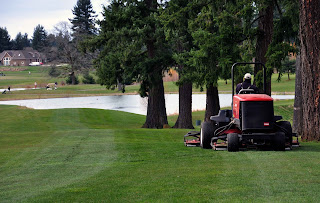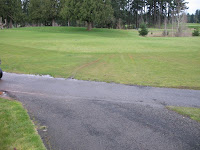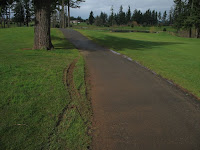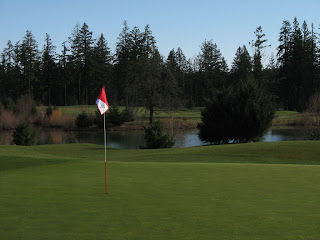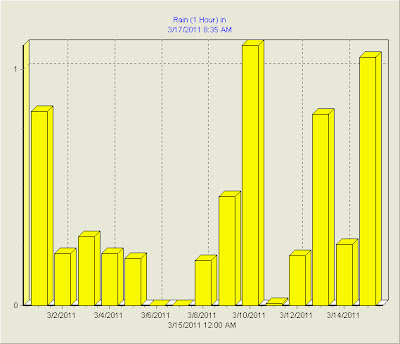
As I write my Monday report here on Friday morning my heart is heavy for all those effected by the Earthquake and tsunami in Japan. Also heavy on my mind are the folks at Farm Links. Pat Jones from
Golf Course Industry reported on Facebook first thing this morning that the entire maintenance facility was destroyed by fire. The cause is yet to be known but it sure opens your eyes of consequences of such a fire. As you can see by this photo nothing is spared. I am somewhat relieved that we have a sprinkler system installed in our barn and if this were to happen it may not be quite so bad. Non the less it is hard to imagine what they are going through. The one thing for sure is that local courses from as far away as Atlanta are probably stepping up to help them out. That is the nature of our business. If we were closer we would be there too.

On a lighter subject, early last week I had the opportunity to visit the Canadian Turf Conference in Vancouver BC as a guest of Brett Young, a fertilizer and seed distributor from across Canada. Brett Young is introducing the
Redox Turf line of products in Canada and asked me to share my experiences with the product. I would like to thank Brett Young for all their wonderful hospitality. They are a first class organization with a first class sales team. I met a bunch of great superintendents and had an opportunity to catch up with some old friends as well.
I have written about this line of fertilizer before and as you know have been very pleased with its performance. What attracted me initially to this product is the science that is behind it. As I have learned how this product works I have become much more aware of how inefficient standard fertilization is. With previous programs we seemed to be on a roller coaster ride, now our color is much more uniform and the growth is consistent without flushes. Without realizing what was happening, we basically cut our nitrogen inputs on our greens in half. The nice thing about the program is we control the amount of nitrogen that we apply. If we need a tenth we give it a tenth if we need more we do so. So far in August over the last two years we have completely removed nitrogen from the greens for as long as forty-five days.
Redox doesn't sell nitrogen, they provide a carbon source combined with micro and macro-nutrients along with organic acids which react with soil to free up nutrients which are commonly tied up within the soil colloid. The program is based on your individual soil test so what may be prescribed for one golf course may not be the same as the other.
The one thing I must stress is we have
not limited the nitrogen available to the plant by reducing our inputs, conversely, we are seeing that the plant receives the same or more but by means of providing the correct products to make the soil a more balanced medium. When we do this it simply amounts to less nitrogen needed as an additional input.
Since I am all for promoting sustainability, this product ranks on the top for reducing inputs while increasing turf quality. We have been so pleased that this year we are incorporating the fairways and the tees into the program. For now we will continue to use Staab to spray the fairways but will be looking into setting up our own sprayer with "Boominator" nozzles to allow us to spray with a forty foot swath. I will post updates on the program as the season progresses. I would be more than happy to entertain any questions anyone may have on this program. I would not normally come out and promote one program over another but this one seems to be completely unique to any other I am familiar with, and it works.
Conditions

Over all the course is in great condition. The staff has done a magnificent job picking up the debris and preparing the course for Saturday Men's Club season opener. You will notice a couple new drainage grates along the path on eleven as well as a drier than normal bunker on the twelfth hole. Friday the guys wrapped up the drainage for the third time in this bunker. As you can see from this photo there is a tremendous amount of clay along the bottom. When it gets wet it seems to collapse around the trench and seal off any way of water leaving the bunker. So to keep from this happening we will be hand raking this bunker during to winter to avoid having to dig it up again.
Carl was so impressed with this clay that he set some aside to build his own wood fire pizza oven. I could swear this looks just like the stuff we made pinch pots with in school back in the days. And to think this is what we are growing grass on!
Finally, on Thursday Mike and I attended the OGCSA Chapter Meeting held at Landon Farm. The final speaker was Rod Hill, our local weather man from KGW News Channel 8. In addition to his roll as a TV "weather guesser" Rod hosts a local weather site called
Rod Hill Forecast that gives a pretty darn good outlook for our local weather. He also gives a golfing forecast as well. We actually have a link to Rods site off of Stone Creek's web page. By clicking on the icon it will take you directly there.
Pictured here is Randy Schults, from Tualatin Country Club and Rod Hill. If you ask me Randy kind of has a smug look on his face as if saying, "Can you believe how short this guy is?" Thanks for the picture Randy!




